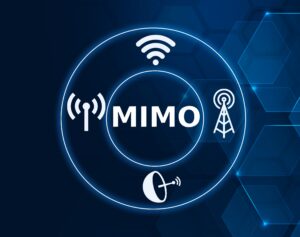Wireless communication systems continue to demand reliability, enhanced performance and bandwidth efficiency, topics we touched upon in our previous papers ‘LTE Higher Data Throughput MIMO and Carrier Aggregation’ and ‘MIMO Antennas for Complex Applications’. The demand for 5G based on analyst forecast continues at pace driving requirements for increased link capacity and spectral efficiency.
• 5 Billion people are forecast to be accessing the internet via mobile devices by 2025
• 5G coverage will roll out rapidly to cover 40 per cent of the global population by 2025
• 5G will account for almost 1 in 7 connections (14 per cent) by 2025
• The global penetration rate for all mobile connections will reach 110 per cent worldwide by 2025
• 9 Billion mobile connections by 2025
• 5.9 Billion unique subscribers in 2025
• 25 Billion Internet of Things devices globally by 2025 (11.4 Billion Consumer IoT (internet of things) devices & 13.7 Billion Industrial IoT devices in 2025)
• Global Mobile Annual Revenue of $1.1 Trillion in 2025
Source: Mobile World Congress Daily, GSMA Intelligence. 1 March 2018
The 3rd Generation Partnership Project (3GPP) specification calls for operability in both static and mobile locations with data rates of one gigabit and above. Mobile devices come into two main categories: Those that are stationary or moving at low speeds typically up to 15km/h and those that have the potential to move at higher speeds such as public and private transport, here speeds up to 500km/hr may be required. To achieve these use cases and deliver high-speed data and video, the specification accommodates multipath signals.
MIMO (Multiple Input and Multiple Output) antenna systems continue to play a key role, by using Spatial Multiplexing and Spatial Diversity to achieve better signal strength. MIMO antenna systems help mitigate the multipath effects such as fading which otherwise occur in a SISO (Single In Single Out) antenna system.
MIMO antenna systems are more productive if the multiple channels used by multiple antennas are highly uncorrelated from each other. With MIMO you get multiple independent channels due to the multipath propagation. In this case, one channel could be in direct line of sight, and one could bounce from an adjacent building. If the channels are sufficiently independent, different data can be sent down each channel giving greater throughput than if you had just one path, the more antennas you have at both ends, the more independent channels can be accessed and utilised.
In dense locations, LTE base stations on tall buildings will naturally encounter multipath transmissions and as buildings and objects absorb and reflect the transmitted signals, long and short paths are generated.

Types of Multipath MIMO
There are two types of Multipath MIMO antennas with advantages and disadvantages and their own specific applications.
Single-user multi-antenna MIMO is one device, either static or mobile, connected by multiple antennas to a multi-antenna base station or access point. This enables multiple streams of data over various connection paths simultaneously providing reduced errors and faster connections by combining results over the multiple paths.
Multi-user multi-antenna MIMO consists of several devices using multiple antennas, in this case, many devices can utilise the multiple paths to connect to many other devices. A typical application could be a vehicle-to-vehicle communication system offering multi-user communications.
Advantages and Disadvantages:
Single-user multi-antenna – A single user cannot send multiple signals to multiple targets simultaneously; it utilises all its MIMO functions for one target or connected point and then moves to the next and this is described as successive connection. This method is ideal for reducing the interference from scatter or fading due to buildings or obstacles by combining the data from several streams and eliminating the errors. In lower noise environments this method can be used to increase data throughput by dividing the data across several streams in the method of Beam Forming.
Guiding the direction of the RF signal allows you to control the signal propagating phase over multiple antennas. The RF energy is focused on a single user boosting the signal to noise ratio wherever the user is located. By using this method, network buffering is minimised, potential data transmission speed is enhanced, it breaks up the network bandwidth and allows high speed downstream (broadcaster to client).
Using multiple signal paths for processing enables Beam Forming to focus the transmission towards a specific target or user, increasing range and reliability while reducing interference effects. It provides a method of BER (Bit Error Rate) correction by utilising advanced algorithms over multiple signals optimising the transmission paths.
Multi-user multi-antennas – Multiple devices communicate with multiple users or other access points enabling a true multi-user network experience. This approach shares the available bandwidth across the devices and access points and is called simultaneous communication. Simultaneous communication enables cMIMO (cooperative MIMO) a form of cooperative communication system. By grouping wireless devices together, they can operate as virtual multi-antenna end points, boosting throughout and giving expanded network coverage to all its connected clients.
The major disadvantage of multi-user MIMO and true multi-user communication is focussed on the cost of complicated and expensive signal processing. It is significantly more expensive to implement and operate when compared to single-user MIMO. In addition, more complex signal processing equates to higher power consumption and modern requirements dictate lower power operation and not all devices today are compatible.
Diversity and Reliability
Antenna Diversity in MIMO also known as Spatial Diversity is a process used to overcome multipath signal fading to improve radio link reliability. The more antennas the better the ability to receive signals from different directions and orientations, meaning better signal spread no matter the quality of signal or noise content providing a more reliable and robust connection. The antennas need to be independent, have good isolation and operate different radiation patterns and as previously mentioned they need to be uncorrelated. The standard measure is referred to as the ECC (Envelope Correlation Coefficient), if paths and performance overlap the overall system performance degrades significantly.
There are three types of antenna diversity available in MIMO systems, the objective being to get as many antennas as possible into the smallest space possible without interaction.
1. Frequency Diversity: The signal is transmitted over two carrier frequencies, spaced ∆f such that each signal is on a different frequency.
2. Time Diversity: The same signal is re-transmitted with a delay ∆t such that each signal operates a different time.
3. Spatial Diversity: RX and TX have multiple antennas, spaced (x) meters apart and in alternate polarisations such that the signal travels via a different spatial direction.
Comparison of Gains
• Time/Frequency diversity
o Frequency or time are sacrificed
o No antenna array gain
o Average receive signal to noise ratio remains constant for all channels
• Spatial diversity
o No additional bandwidth available
o Increase in average signal to noise is possible
o Additional array gain is possible
Conclusions
In conclusion we see that multipath transmissions can cause signal problems, yet when used correctly in your design can achieve much improved reliability and both improved data throughput and higher connection rates. Multiple antennas offer a receiver several observations of the same signal. Each antenna will experience a different interference environment. Thus, if one antenna is experiencing a deep fade, it is likely that another has a sufficient boosted signal. Collectively such a system can provide a robust link.
Antenna diversity schemes require additional hardware and integration costs versus a single antenna system however, modern devices support the ability to offer MIMO with minimal increase in cost to non-MIMO systems. Multiple signals require greater processing in the receiver, which can lead to more complex processing requirements and therefore higher power consumption. With signal reliability being a key factor in today’s real time applications, the use of multiple antennas is an effective way to improve overall system performance and provide a superior solution.
Siretta understand the challenges faced and have developed their own Antenna Selector Tool – www.siretta.com/products/antennas/antenna-selector/ to reduce time to market. Our portfolio includes cellular modems & terminals, routers, cellular network analysers, RF antennas including MIMO antennas and solutions for WLAN, LoRa and Sigfox. We offer RF cable assemblies and RF accessories. Frequencies are typically within the 75MHz – 5.8GHz range covering the HF, VHF, ISM, Cellular, GNSS frequencies.
We also offer bespoke customer solutions, and our design services are supported by an experienced team of dedicated development & application engineers as well as software specialists offering complete end to end solutions with a heavy emphasis on high level system design.


